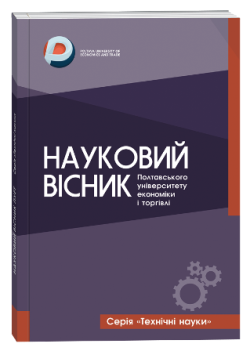THE COMPLETE PROCESSING OF GRAPES FOR ALCOHOLIC AND NON-ALCOHOLIC BEVERAGES
Abstract
The article is devoted to the complex processing of raw materials, the use of secondary products after the processing of Moldova grapes as a source of biologically active substances in the technology of alcoholic and non-alcoholic beverages. The aim of the research. the processing of grapes to obtain alcoholic and non-alcoholic beverages using grape juice and hydroalcoholic extracts from grape pomace. Research methods – organoleptic, physical, chemical methods for determining the quality of raw materials, semi-finished products and finished products. Results. An analysis of the quality indicators of grapes, juice and pomace was carried out and their rich chemical composition was confirmed, and the presence of a significant content of phenolic and coloring compounds makes it possible to use the products of its processing as a natural antioxidant. To obtain juice, the method of direct extraction was used as the most rational in the conditions of the restaurant industry. The expediency of using the extraction process with a 50 % water-alcohol solution of pomace from grapes has been established. A technology for carrying out the extraction process is proposed and the quality indicators of the obtained extract are determined. The directions of using grape juice in the technology of blended juices and soft drinks, water-alcohol extract from pomace in the technology of low-alcohol drinks are considered. It is shown that the drinks have a balanced sweet-sour taste, pleasant aroma with light refreshing tones, increased nutritional and biological value, which indicates the possibility of using grape juices and water-alcohol extracts from pomace in the composition of drinks. Conclusions. The expediency of introducing complex processing of Moldova grapes in the technology of alcoholic and non-alcoholic beverages is proved.
References
2. Краснова О. І., Плужнікова Т. В., Краснов О. Г. Проблема вживання алкогольних та слабоалкогольних напоїв в підлітковому віці. Сучасні медичні технології. 2020. Т. 2. С. 44–48. DOI: https://doi.org/10.34287/MMT.2(45).2020.8
3. Субота В. В. Харчові добавки: класифікація та небезпека. Інтеграційні та інноваційні напрями розвитку харчової індустрії: матеріали п’ятої міжнародної науково-практичної конференції, Черкаси, 4-5 листопада 2021 року. 2021. С. 18–22. URL: https://er.chdtu.edu.ua/handle/ChSTU/3487
4. Каліновська Т. В. Використання виноградних вичавок для підвищення харчової цінності цукерок з комбінованими корпусами : дис. … канд. техн. наук : 05.18.01 «Технологія хлібопекарських продуктів, кондитерських виробів та харчових концентратів». Київ, 2014. 152 с. с.
5. Global Footprint Network. Choice Reviews Online. 2009. Vol. 46, no. 11. P. 46–61. DOI: https://doi.org/10.5860/choice.46-6153 (date of access: 25.04.2022).
6. Khrypiuk V. The food industry of Ukraine: retrospective analysis and modern problems of development. Ekonomika APK. 2018. No. 9. P. 77–86. URL: https://doi.org/10.32317/2221-1055.201809077 (date of access: 25.05.2022).
7. Про схвалення Національної стратегії управління відходами в Україні до 2030 року : Розпорядж. Каб. Міністрів України від 08.11.2017 р. № 820-р : станом на 17 верес. 2020 р. URL: https://zakon.rada.gov.ua/laws/show/820-2017-р#Text (дата звернення: 25.04.2022).
8. Каліновська Т. В., Крапивницька І., Оболкіна В. Використання вторинних продуктів переробки винограду під час розробки інноваційних технологій кондитерських виробів. Обладнання та технології харчових виробництв. 2013. Т. 30. С. 75–80.
9. Хомич Г. П., Капрельянц Л. Фенольні сполуки дикорослих плодів і ягід: склад, властивості, зміни при переробці : монографія. Полтава : РВК ПУЕТ, 2013. 217 с.
10. Дослідження якості виробів із дріжджового тіста і пісочного печива з використанням кріопорошків із рослинної сировини / А. М. Чуйко та ін. Восточно-Европейский журнал передовых технологий. 2014. Т. 2, № 12. С. 68–75.
11. Yu J., Ahmedna M. Functional components of grape pomace: their composition, biological properties and potential applications. International Journal of Food Science & Technology. 2013. Vol. 48, no. 2. P. 221–237.
12. Towards integral utilization of grape pomace from winemaking process: A review / C. Beres et al. Waste Management. 2017. Vol. 68. P. 581–594. URL: https://doi.org/10.1016/j.wasman.2017.07.017
13. Синенко Т. П., Фролова Н. Е. Використання виноградних вичавок в технології смакоароматичних добавок. Інноваційні технології в готельно-ресторанному бізнесі : матеріали ІХ Всеукр. науково-практ. конф., м. Київ, 19 трав. 2020 р. – 20 трав. 2022 р. Київ, 200. С. 207–208.
14. Тельпіс П. І. Використання екстракту з виноградних вичавок у виробництві желе. Використання екстракту з виноградних вичавок у виробництві желе. 2019. С. 42–43.
15. Салєба Л., Сарєбєкова Д. Г. Удосконалення процесу екстрагування антоціанів з використанням ферментних комплексів. Вісник Хмельницького національного університету. 2021. Т. 1, № 293. С. 222–226.
16. Хомич Г. П. Отримання екстрактів з вичавок дикорослої сировини і використання їх у безалкогольній промисловості. Збірник наукових праць ДонДУЕТ. 2012. Т. 2, № 13. С. 310–316.
17. Хомич Г. П., Левченко Ю. В. Комплексна переробка плодів хеномелесу. Наукові праці Одеської національної академії харчових технологій. 2016. Т. 46, № 2. С. 75–80.


